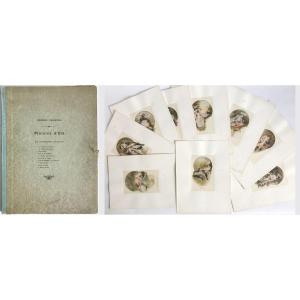(Leipzig 1857 - 1920 Großjena)
Temptation
1898
plate 10 from Opus XI, Vom Tode (Of Death), part 2
original etching and aquatint
45.4 x 35.6 cm (plate); 61.4 x 46.2 cm (sheet)
fine proof on japon paper
reference : Singer no. 238 v
Selected bibliography :
Bénézit, Paris, Ernest Gründ Editeur
H. W. Singer, Max Klingers Radierungen, Stiche und Steindrucke. Wissenschaftliches Verzeichnis, Berlin, Amsler & Ruthardt 1909
Notable museums:
The Metropolitan Museum of Art, New York (has a proof with iconography identical to the present sheet) ;
Staatliche Kunsthalle, Karlsruhe (has a print identical to this sheet)
Find out more about Max Klinger :
"Max Klinger (1857-1920), German painter, sculptor and engraver, figure of Symbolism: the dictionary definition is not wrong. Klinger was in fact one of those artists who, in the last third of the 19th century and up until the First World War, placed allegories, often inspired by Antiquity, before the eyes of their contemporaries, who were generally more preoccupied with industry and the colonies.
Klinger had a cordial relationship with Arnold Böcklin (1827-1901). He was a contemporary of Franz von Stuck (1863-1928), who loved painting nymphs, centaurs, divinities and demons as much as he did. During the period of its success in German-speaking countries, this movement was little seen and even less appreciated in France - because it came from Germany. The fact that Klinger lived in Paris from 1883 to 1886, that he returned there to meet Rodin, that he was a reader of Flaubert and Zola, made no difference - and, in any case, he was virtually unknown in France.
A regrettable oversight, because not only was Klinger one of the most surprising artists of his time, far beyond the general Symbolist style, but when he died he had admirers who went on to leave their mark on twentieth-century art: Giorgio De Chirico, Max Ernst and Max Beckmann.
[...] As a sculptor, he accepted a neoclassical style whose rules he only slightly disrupted. As a painter, he was more disconcerting, occasionally slipping unexpectedly into Cézanne. But this is nothing compared to his uniquely free use of etching.
On copper, he allows himself everything, especially as he knows the techniques by heart. He frees himself from the principles of perspective, shortening or segmenting it. He enclosed his figures in narrow spaces, wedged between rocks, thick vegetation or walls. He likes to suspend them in levitation, in mid-air, and to plunge them underwater, aquatic depths seen in cross-section as in natural history books.
We often think of these books. Klinger takes from them the pterodactyl, the giant tortoise, the puma, the black swan and marine animals, such as newts, whose names are unknown, assuming that he did not invent them. In the illustrated history and archaeology books that abounded from the mid-nineteenth century onwards, he found scenes of the lives of savages, barbarians and nomads, from prehistory to the present day, including the Middle Ages and the Thirty Years' War. Added to this visual memory are biblical iconography and sacred and secular allegories. And, in addition, everything that Klinger sees in the cities where he lives - Leipzig - or stays - Paris, Rome, Berlin."
- Extract from Philippe Dagen, "Max Klinger, fantasque maître graveur", Le Monde, 25 July 2012.








































 Le Magazine de PROANTIC
Le Magazine de PROANTIC TRÉSORS Magazine
TRÉSORS Magazine Rivista Artiquariato
Rivista Artiquariato